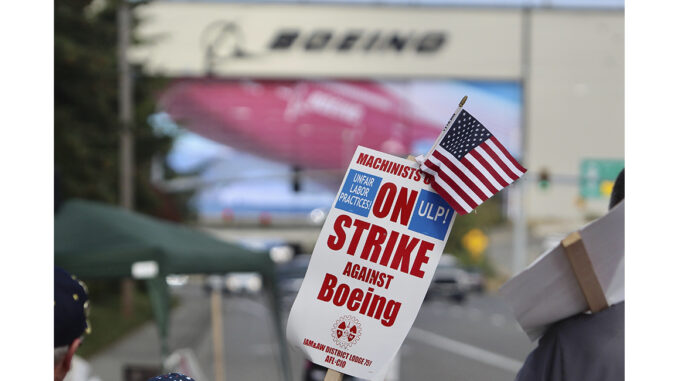
A labor strike at Boeing has shown no signs of ending. The walkout by 33,000 union machinists entered its eighth day, and the company started rolling out furloughs of nonunion employees to conserve cash.
Federal mediators joined talks between Boeing and the International Association of Machinists and Aerospace Workers this week, but company and union officials reported little progress during the first two sessions.
“While we are disappointed the discussions didn’t lead to more progress, we remain very committed to reaching an agreement as soon as possible that recognizes the hard work of our employees and ends the work stoppage in the Pacific Northwest,” Boeing CEO Kelly Ortberg said in a note to employees.
The walkout started Sept. 13 when members of a regional district of the IAM union voted 96% in favor of a strike after they rejected a proposed contract that would have raised their pay by 25% over four years. A 30% increase offer was also rebuffed. Workers say they want raises of 40% and restoration of traditional pension benefits that were eliminated about a decade ago.
Union leaders, who recommended approval of the contract offer, pivoted quickly and surveyed the rank-and-file to learn what they wanted in a new contract.
The Federal Mediation and Conciliation Service met with both sides last, but mediation ended without a resolution. “While we remain open to further discussions, whether directly or through mediation, currently, no additional dates are scheduled,” IAM District 751 officials said.
The strike mainly involves workers at factories in the Puget Sound area of Washington state, and it will quickly affect Boeing’s balance sheet. The company gets much of its cash when it delivers new planes. The strike has stopped the production of 737s, 777s, and 767s, which Boeing has been delivering at a rate of nearly one per day.
Ortberg, who became the aerospace giant’s chief executive early last month, announced this week that the company’s money-saving steps would include furloughing managers and other nonunion employees.
Terry Muriekes, who has worked at Boeing for 38 years, picketed outside the assembly plant in Everett, Washington, where 777s and 767s are built, and noted the rolling furloughs.
“I’ve never seen Boeing do that before. They might be feeling the pinch, feeling the hurt a little bit, you know — trying to save some money after spending so much money on four CEOs in 10 years that all walked away with multiple golden parachutes,” said Muriekes, who went through four previous Boeing strikes, including the last one, in 2008. “The company is doing what it has to do, I suppose.”
Nearby, Bill Studerus, a 39-year Boeing veteran, carried a “Strike” sign and an American flag.
“When you’re on strike, you have no income, so that is challenging for all of us, no matter what age you are,” Studerus said. “My heart tells me that, hopefully, this will end soon. I mean, we all want to get back to work, and we all want to be the Boeing family that we have always been.”
Boeing’s cost-saving moves, including a hiring freeze, travel restrictions and a 25% salary cut for top executives, will affect the company’s airplane, defense and space, and global services businesses. Under the furlough plan, tens of thousands of nonunion workers will be forced to take one unpaid week off every four weeks. Ortberg said activities related to safety, quality and customer support would continue, as would production of the 787 Dreamliner, a large plane built by nonunion workers in South Carolina.
The Society of Professional Engineering Employees in Aerospace said its board rejected a company request to include the 19,000 Boeing employees it represents in the layoffs. President John Dimas said the union — Boeing’s second-biggest after the IAM — saw no compelling reason to alter its contract, which prohibits furloughs. “To repair its balance sheet, Boeing needs to make striking machinists an offer that would end the current dispute and put them back to work,” Dimas said.
Concern about a cash crunch is prompting rating agencies to consider downgrading Boeing’s credit to noninvestment or junk status, which would embarrass Boeing and increase its borrowing costs. According to a regulatory filing, Boeing had $58 billion in debt and $11 billion in cash on June 30. Chief Financial Officer Brian West said the company burned $4.3 billion in the second quarter. The company delivered 83 commercial planes in July and August, almost as many as it did in the entire second quarter, but that faster pace will stop if the strike lasts very long.

